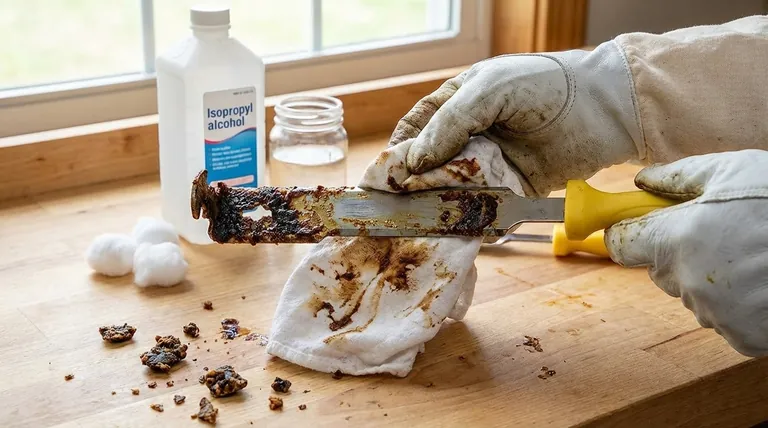To remove sticky bee glue, also known as propolis, the most effective and widely used solvent is rubbing alcohol (isopropyl alcohol). Propolis is a resin-based substance, meaning it will not dissolve in water but breaks down quickly when exposed to a strong alcohol solvent.
The core reason soap and water fail to remove propolis is that it is not water-soluble. The key is understanding that propolis is a plant resin, which requires an alcohol-based solvent to effectively dissolve its sticky, glue-like structure.

Why Propolis Is So Difficult to Clean
The Composition of Bee Glue
Propolis is a complex mixture created by bees from tree buds, sap flows, and other botanical sources. Its primary components are plant resins and balms, beeswax, essential oils, and pollen.
The high concentration of plant resin is what gives propolis its legendary stickiness and adhesive properties.
An Alcohol-Soluble Problem
Because propolis is resinous and waxy, it is hydrophobic, meaning it repels water. This is why washing with soap and water does little more than smear the stain.
However, these same resinous compounds are alcohol-soluble. Alcohol acts as a powerful solvent that breaks down the chemical bonds of the resin, dissolving the propolis and allowing it to be wiped away easily.
The Practical Removal Process
For Hands and Skin
Apply a small amount of rubbing alcohol to a paper towel or cotton ball. Rub the affected area gently until the propolis dissolves and lifts off the skin.
After the propolis is gone, wash your hands thoroughly with soap and water to remove any remaining residue and the drying alcohol.
For Beekeeping Tools and Equipment
For hive tools, smokers, and other hard equipment, you can soak a rag in rubbing alcohol and wipe them down.
For heavy buildup, you can either soak the end of the tool in a small jar of alcohol or use the alcohol to lubricate the propolis while you scrape it off with a putty knife or sharp edge.
For Clothing and Fabrics
Removing propolis from fabric is trickier, as alcohol can potentially damage certain dyes or materials.
First, try placing the garment in a freezer for a few hours. The cold temperature will make the propolis hard and brittle, allowing you to crack and scrape most of it off.
For any remaining stain, test the rubbing alcohol on an inconspicuous area (like an inside seam) first. If it is safe, dab the stain with an alcohol-soaked cloth until it dissolves, then launder as usual.
Understanding the Trade-offs and Cautions
Choosing the Right Alcohol
Standard isopropyl alcohol (rubbing alcohol) is the perfect choice. Higher concentrations, such as 91% or 99%, will work faster and more effectively than the more common 70% solution.
Denatured alcohol can also be used, but rubbing alcohol is cheaper and more readily available.
Potential for Surface Damage
Remember that alcohol is a solvent. It can dull or strip finishes from varnished wood, damage certain plastics, or remove paint.
Always test the alcohol on a small, hidden spot before applying it to a large or sensitive surface to ensure it won't cause damage.
Safety First
Rubbing alcohol is flammable and produces fumes. Always work in a well-ventilated area and keep it away from open flames or sparks.
Making the Right Choice for Your Goal
- If your primary focus is cleaning your hands or skin: A cloth dampened with standard rubbing alcohol is your safest and most effective tool.
- If your primary focus is cleaning hard metal tools: Use a high-concentration alcohol for quick results, scraping to remove thick layers.
- If your primary focus is treating clothing: Always start with the freezing method before resorting to a careful spot treatment with alcohol.
By using the right solvent for the job, you can easily manage even the most stubborn propolis stains.
Summary Table:
| Cleaning Goal | Recommended Method | Key Consideration |
|---|---|---|
| Hands & Skin | Wipe with rubbing alcohol-soaked cloth. | Wash with soap and water afterward. |
| Beekeeping Tools | Wipe, soak, or scrape using high-concentration alcohol. | Effective for metal surfaces; test on finishes. |
| Clothing & Fabrics | Freeze to brittle, then scrape; spot-treat with alcohol. | Always test alcohol on a hidden area first to prevent damage. |
Struggling with stubborn propolis on your equipment? HONESTBEE supplies commercial apiaries and beekeeping equipment distributors with the high-quality, durable tools and supplies needed for efficient hive management. Let us help you keep your operation running smoothly. Contact our expert team today to discuss your wholesale needs and discover the right equipment for a cleaner, more productive apiary.
Visual Guide

Related Products
- Heavy Duty Stainless Steel Frame Cleaner with Plastic Handle
- Professional Stainless Steel Frame Cleaner with Ergonomic Wood Handle
- Metal Queen Bee Excluder for Beekeeping
- Professional Plastic Queen Excluder for Modern Beekeeping
- High Performance Plastic Queen Excluder for Beekeeping and Apiary Management
People Also Ask
- What qualities are important for someone starting in beekeeping? Build a Thriving Apiary with the Right Mindset
- How can a hive tool be cleaned? Master Quick Field Cleaning vs. Deep Sterilization
- What are some safety precautions and care tips for hive tools? Ensure Beekeeping Efficiency and Hive Health
- How is a hive tool used for scraping and cleaning? Master Hive Maintenance for a Healthy Colony
- What is the purpose of the frame cleaning tool? A Precision Tool for Efficient Frame Maintenance



















